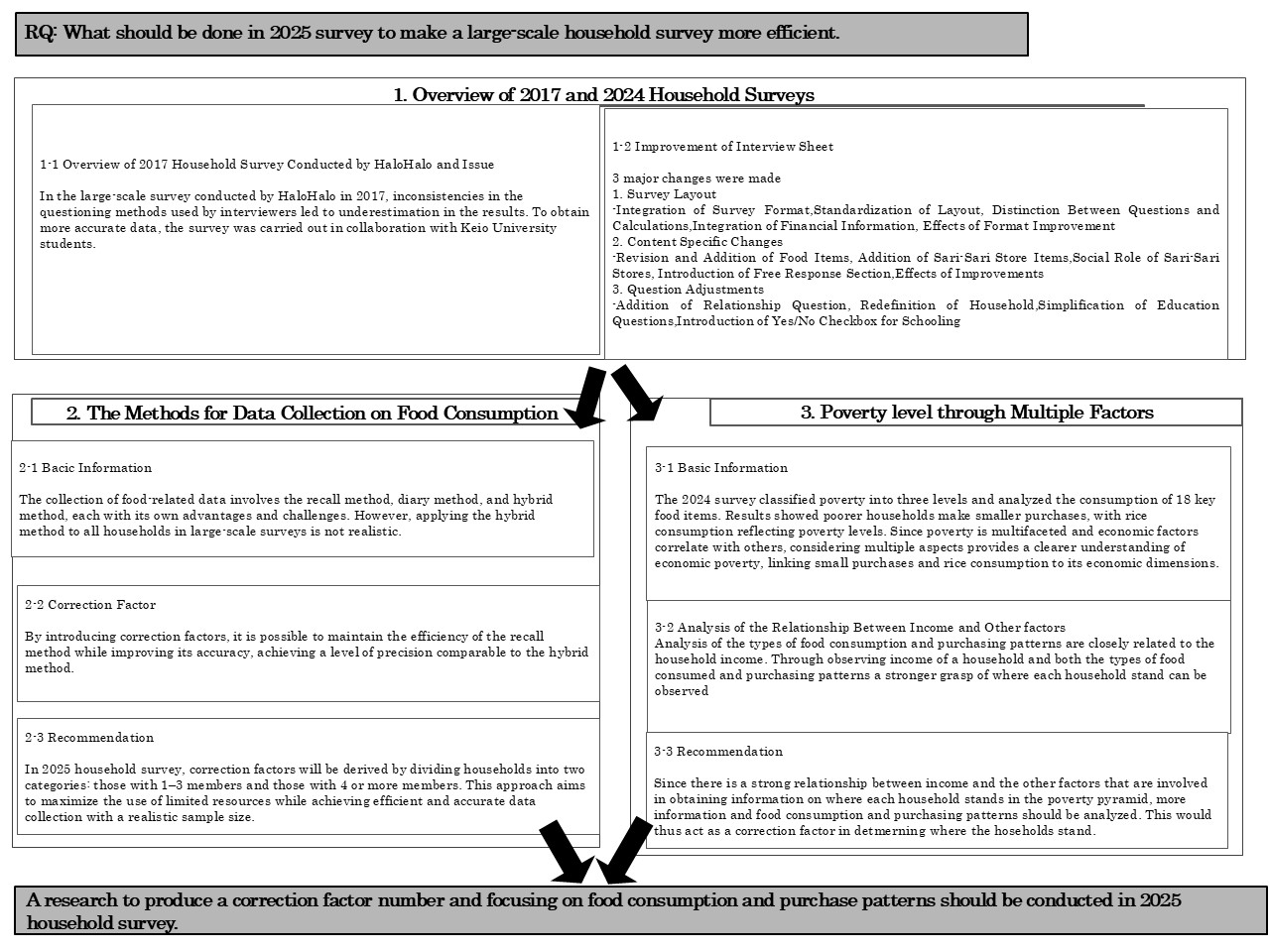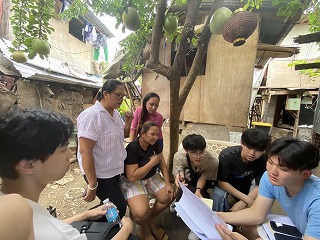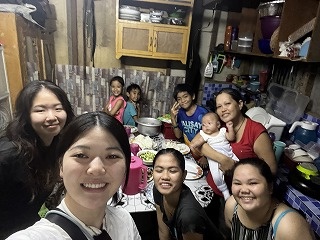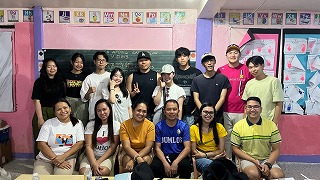Recommendations for 2025 Household Survey
Naoto Hakomori, Honoka Horiuchi, Kodai Kikuhara and Hina Tanaka
Cebu Island is surrounded by beautiful seas and is a popular tourist destination for many Japanese tourists. However, while the tourism industry is well developed, there are areas on the island where impoverished people live. In contrast to the island's glamorous image, people in the slums, where houses and people are densely packed together, are forced to live a poor life of the day.
To discover the issues in these poor areas, the non-profit organization HaloHalo conducted a household survey in three areas in 2017, covering a total of 309 households to determine the living conditions. However, 2017 household survey conducted by HaloHalo reported an average monthly income of only 4,634 Philippine pesos, falling short of the bottom 1% in the 2018 FIES (Family Income and Expenditure Survey) conducted by the Philippines government, clearly an underestimation.
Therefore, HaloHalo planned a new household survey in 2024 and took inspiration from FIES to reconstruct the existing interview sheet and survey methodology to get better results while keeping costs down. However, there are still issues to be addressed to conduct a large-scale survey in the future to obtain accurate data, and 2025 survey is needed.
In Hakomori, Horiuchi, Kikuhara, Tanaka, Tokunaga and Tozawa (2024), 2024 household survey was conducted with a modified interview sheet layout. A hybrid method combining diary and recall methods was introduced for 2024 survey methodology. The diary method involves respondents recording data themselves or with the assistance of interviewers, allowing for the collection of accurate consumption data but posing challenges in terms of burden and cost. In contrast, the recall method asks respondents to recall a specific period in the past and provide oral responses, enabling the collection of extensive data in a short time but facing issues with data accuracy due to recall errors. In Deaton and Grosh (2000), standardizing survey methods enhances the comparability of data in large-scale household surveys and improves reliability. Therefore, this paper proposes the introduction of a correc-tion factor to maintain the efficiency of the recall method while correcting memory errors and reporting biases inherent in the recall method in 2025 survey.
In addition, 2024 survey includes a new section covering 18 key food items based on FIES to better understand household income levels through food consumption. For ex-ample, in Abdullahi, Musa, Usman, Alhassan and Nahantsi (2019), rice can be an indicator of poverty as those who are in poverty tend to consume a higher amount.
This paper presents changes to 2017 household survey in 2024 and an analysis of these changes. It then proposes 2025 household survey aimed at improving the accuracy and efficiency of large-scale data collection. Section 1 provides an overview of 2017 and 2024 household surveys, noting that the interview sheet was changed after problems were identified with 2017 survey. Section 2 focuses on the measurement of poverty using income data, with particular attention to data collection on food consumption. In addition, the introduction of a correction factor to adjust the data collection method is proposed. Section 3 focuses specifically on different food consumption, small purchases as these factors are interrelated to the income of each household. Thus, providing that patterns of food consumption and small purchases are closely related to the economic dimensions of poverty.
In conclusion, 2025 household survey for large-scale research should include a research to produce a correction factor number and focusing on food consumption and purchase patterns for accurate measuring poverty.

Table of Contents
Introduction
1 Overview of 2017 and 2024 Household Surveys
1-1 Overview of 2017 Household Survey Conducted by HaloHalo and Issue
1-2 Improvement of Interview Sheet
2 The Methods for Data Collection on Food Consumption
2-1 Basic Information
2-2 Correction Factor
2-3 Recommendation
3 Income Level through Multiple Factors
3-1 Basic Information
3-2 Analysis of the Relationship Between Income and Other factors
3-3 Recommendation
Conclusion
References
References
- Abdullahi, A. N., J. Musa, M. Usman, F. B. Alhassan and S. Nahantsi, “Consumer De-mand and Preference of Local and Imported Rice among Households in Sokoto Metropo-lis, Nigeria,” Direct Research Journal of Agriculture and Food Science, Vol. 7, No. 10, 2019, pp.295-301.
- Deaton, Angus and Margaret Grosh, "Consumption", in Grosh, Margaret and Paul Glewwe eds., Designing Household Survey Questionnaires for Developing Countries Chapter 5, pp. 91-133, World Bank, 2000.
- Hakomori Naoto, Honoka Horiuchi, Kodai Kikuhara, Hina Tanaka, Hiroyoshi Tokunaga and Shusaku Tozawa, “Cebu Field Notes,” Field Note Series, Ohira Satoshi Seminar, Faculty of Economics, Keio University, 2024-kk01, 2024.
Thank you to Christian Antiquiera, Kanji Uehara, Kazusa Doi, Honoko Hashimoto, Kanako Maeda, and Tomoki Mizuguchi for their support in the creation of the Mita-sai paper.
三田祭論文作成にあたり、ご協力いただいたChristian Antiquieraさん、上原莞爾さん、土井一紗さん、橋本ほの子さん、前田可南子さん、水口智揮さんありがとうございました。

|  |
|
Household survey in Cebu セブ島での家計調査の様子 |
Interacting with the local children 現地の子供達と触れ合い |

|  |
|
Visit to a local elementary school 現地の小学校へ訪問 |
Homestay experience ホームステイ体験 |

|  |
|
The people at Tulay Sa Kinabuhi 現地でお世話になったTulay Sa Kinabuhiのみなさん |
Enjoying our time off オフも満喫しました |
論文全文(ゼミ関係者のみダウンロード可)
三田祭ページに戻る